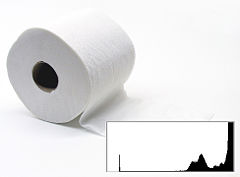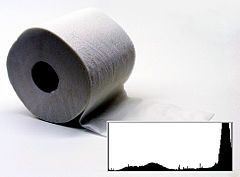Tonal value spread
In photography, tonal value spread is the scaling of the contrast range . The properties of a brightness distribution are transferred to a larger scale .
The opposite of tonal value spreading is tonal value reduction.
principle
Each brightness value of a digital image is stored on a specific scale. For example, the average picture from a digital camera has a scale of 8 bits per color channel - this corresponds to 256 levels of brightness (per color channel). Each brightness value must therefore be saved on one of these 256 brightness levels - intermediate levels are not possible.
The sum of all brightness values of an image can be displayed in a histogram . As a rule, the spectrum of all brightness values is displayed horizontally, while the frequency of these values is shown vertically.
In the original image shown above (center), only about half of the tonal range (with 256 levels of brightness) is used (a typical high key photo ).
With the help of suitable (image processing) software, this brightness distribution can be spread. The original brightness distribution covers a spectrum of around 100 levels; by spreading this brightness distribution is transferred to a spectrum of 256 levels (photo on the right). This creates a new impression of brightness in the image.
The range of contrast of a photo is always increased by a tonal value spread . This creates a higher impression of sharpness - the actual sharpness of the image is reduced (due to interpolation losses ).
In classic photo processing (in the photo laboratory ), tonal value spreading can be achieved using suitable techniques. The following can be mentioned as examples:
- The reproduction on suitable photographic material. Example: document film
- The use of appropriate chemicals. Example: a negative can be reinforced by subsequent treatment in suitable bath approaches. The rudimentary silver grain (or latent silver nuclei) present in the underexposed areas of the image is subsequently blackened and enlarged (through the accumulation of various metal ions, depending on the intensifier bath approach).
- The targeted post-exposure (or dodging ). Example: the automatic image optimization of negative prints in large laboratories.
application
Tonal value spreads serve exclusively to increase the impression of sharpness. Due to the loss of sharpness, the application of this method must be chosen with care.
The tonal value reduction (the opposite of the tonal value spread) is called attenuation in classical photography (for example with Farmer's attenuators ). This allows pictures to be reduced in their contrast range. This is necessary if the large tonal range of a certain medium cannot be reproduced at all. Typical for this is the enlargement of a slide on photo paper. Slides have a significantly higher contrast range than photos (slide: up to 1: 1000; photos: max. 1:40).



